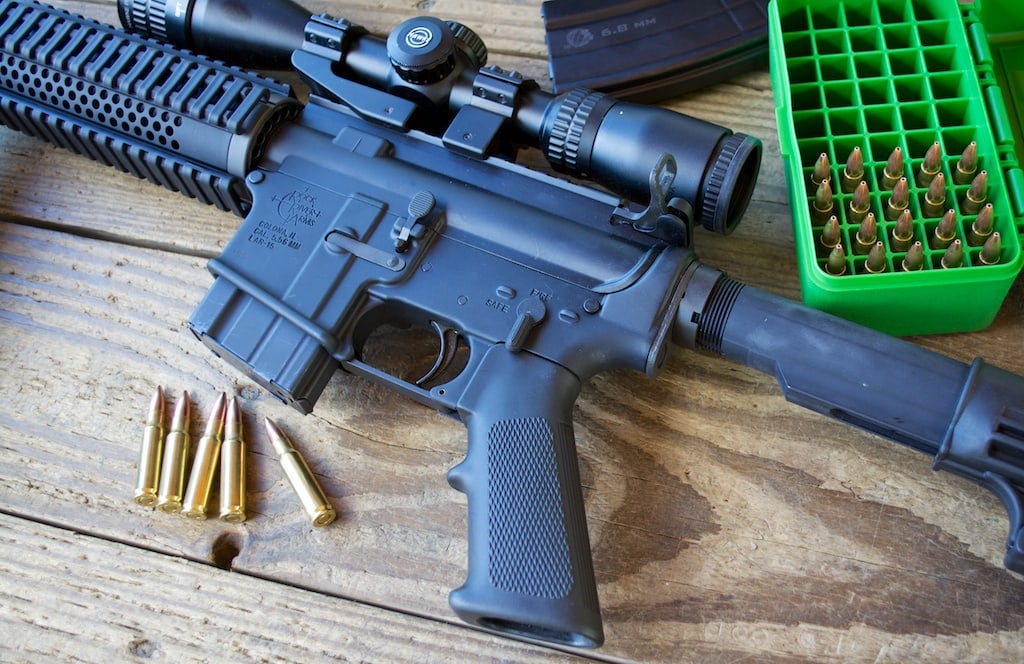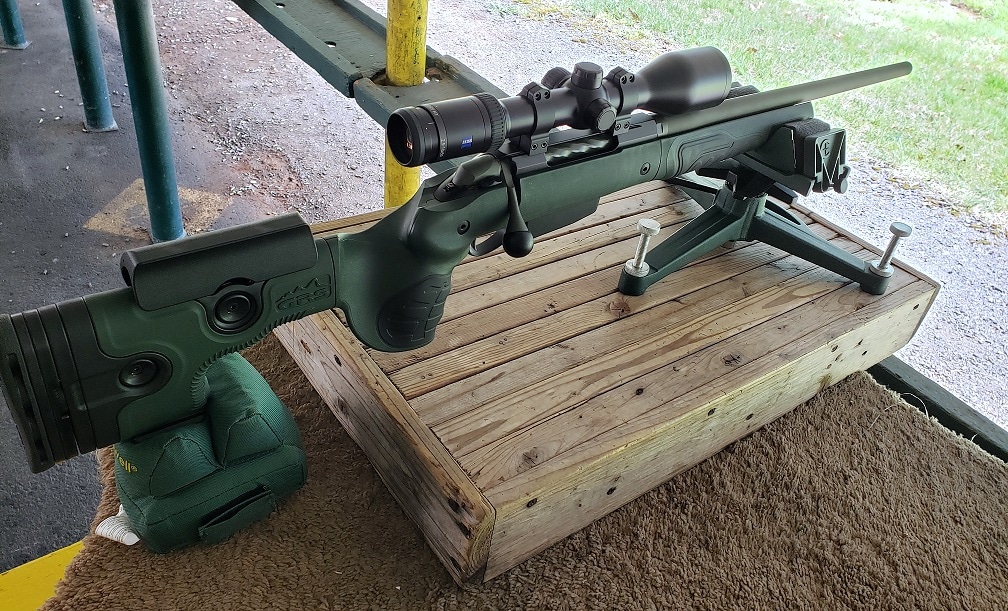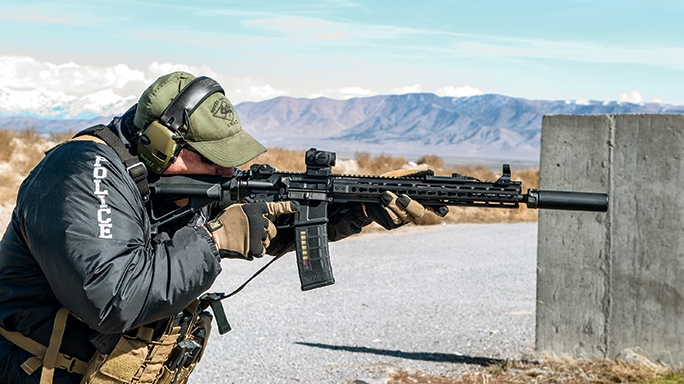The 6.8 SPC has had its fair share of ups and downs since its introduction in 2004. Once seen as a possible replacement for the 5.56 NATO standard-issue cartridges.

It still hasn’t lost its potential. Maybe it’s the next big thing on the weapons market. Let’s understand why the 6.8 SPC is an amazing caliber and any shortcomings it has.
An Overview of the 6.8 SPC
The 6.8 Remington SPC (Special Purpose Cartridge) is a rimless bottlenecked cartridge. It was developed from 2002 to 2004 and as a result of the collaboration between Remington Arms and the US SOCOM and some marksmanship units of the military. In fact, the idea was originally developed by Master Sergeant Steve Holland and Chris Murray under the Enhanced Rifle Cartridge Program.
The 6.8 mm bullet is the same in size as a .270 Winchester bullet. Based on the .30 Remington cartridge, the 6.8 was designed to be an intermediate choice between the 5.56 NATO and 7.62 NATO cartridges. The .30 Remington case was chosen to suit the magwells of the existing M16, M4 and other mag-fed rifles of the military.
The 6.8 SPC was designed to perform better than the standard 5.56 NATO at CQB distances. It delivers about 44% more power than the 5.56 NATO within 300 yards. Making it a perfect choice for SBR’s like the M4. It is also seen as a viable alternative to the 7.62 NATO with lesser recoil and more control in burst or full-auto mode. But only at short range.
Today the 6.8 SPC is available in seven different chambering options. The original Murray 6.8×43 ERC, Remington SAAMI, SPC II (most common today), 6.8 ARP, Noveske Mod 1, and 6.8 Bison from Bison Armory.
The most common bullet weights available for the 6.8 SPC are 85 gr, 110 gr, 115 gr., and 120 gr. The bullet is 0.277 inches in diameter. Same as a .270 Winchester.
A 120 grain 6.8 SPC bullet moves at a muzzle velocity of 2,460 fps and muzzle energy of 1,612 foot-pounds. Showing a drop of 78.8 inches at 500 yards. But only a 19.1 inches drop at 300 yards.
As far as the price of ammo is concerned. These rounds cost anywhere between $1 to $2.5 per round. That’s almost twice compared to the .223 ammo.
What the 6.8 SPC Does Best
The design of this cartridge and the intended purpose of its development clearly indicate two things. This round was designed for close-quarters battle and hard-hitting power. While the 6.8 SPC is not ballistically equivalent to the 7.62 NATO. It does offer somewhat close stopping power. Plus, a better trajectory at short to medium range.
The 6.8 SPC is used by the U.S Special Operations Command in a limited capacity. It was adopted in late 2007 and proved very effective for close-quarter engagements in Iraq. But its use was tested under different situations. It began to falter at long ranges which were very common in the mountainous terrain of Afghanistan.
The 6.8 SPC did not prove to be a versatile cartridge for combat uses. However, in recent years, the round is being designed and further enhanced for adoption as a standard military cartridge. Let’s see where that goes!

As far as civilian applications are concerned. The 6.8 SPC is an amazing small to medium-sized game cartridge. Especially as a hog medicine. It is a great hunting cartridge because of its exceptional hitting power and trajectory within 300 yards. Which is where most of the hunting happens.
Additionally, the 6.8 SPC is also a viable option for home defense uses. Since it was already designed for CQB and working with short barrels. It will help you create a perfect home defense rifle.
Since this round is perfectly compatible with the AR platforms. There are a ton of customizability and accessories options out there. Helping you create the best tactical rifle.
Where the 6.8 SPC Falls Short
The 6.8 started out as an astounding cartridge for the U.S SOCOM. But their interest began thinning out when the shortcomings regarding the long range performance of this round began springing up.
The 6.8 SPC is great for close quarters but as distances increase, it doesn’t compare to the venerable 7.62 NATO. Sure it has advantages in terms of recoil and lesser weight of the cartridge. Plus, more controllability in rapid firing modes. But if a cartridge has to be issued to a regular G.I. It must be versatile.
What is clearly evident from the ballistic performance of this cartridge is its limitation as a short range round.
The next factor to consider is the high price of ammo. The price of a round can go as high as $2.5. Which is not even close to economical when we talk about .223 ammunition or even 7.62 NATO mil surp boxes. So as far as plinking is concerned, you should either look for good handloading equipment or be ready to spend more on ammo.
The availability of ammo is also questionable to some extent. The 6.8 SPC is not very mainstream as 5.56 NATO or 7.62 NATO loads. Overall, this is going to be an occasional-use rifle. Plus, there are very viable alternatives like the .270 Winchester and others that are more common and tested.
How to Take Advantage of the 6.8 SPC
The easiest method to transform your AR-15 into a 6.8 SPC semi-auto rifle is to simply swap the upper receiver. We’ve compiled and reviewed a list of the best 6.8 SPC uppers receivers on the market. That has been tested for exceptional performance.
Immaculate attention was paid when developing the 6.8 SPC to ensure it is similar to the case length of the standard 5.56 NATO cartridges. Especially because it was seen as a potential replacement to the 5.56 NATO. The only difference between an AR-15 and a 6.8 SPC AR is the bolt, barrel, and magazine. Rest all of the parts stay the same.

I’d rather suggest buying a dedicated upper for the 6.8 SPC to ensure a quick switch between calibers. Plus, features such as full-length top rail, quad rails, BUIS, floating handguards, etc can be chosen as per your individual tastes.
An essential component for a 6.8 SPC rifle is a good rifle scope. The cartridge is suitable for short to medium range engagements. SO a 3-9x or 4-12x scope will be the best.
Additionally, you may also rely upon a 1-4x or 1-6x scope for extremely close-quarter hunting. Like bringing down a turkey or something.
Technically speaking, 6.8 SPC rounds can fit a 5.56 NATO magazine. But that is strongly not recommended. Make sure you get dedicated 6.8 SPC magazines for flawless feeding and eliminating any potential problems.
The potential options for upgrading a 6.8 SPC AR are almost endless. Thanks to the customizability of the AR-15 platform. So you can experiment with a lot of things.
Further Reading on 6.8 SPC
The biggest debate you’ll encounter when choosing the 6.8 SPC is a stiff competition from 6.5 Grendel and 6.5 Creedmoor. All of these three cartridges are exceptionally close in terms of performance, hitting power, and bullet size.
We’ve done a detailed review of the 6.5 Creedmoor vs the 6.5 Grendel vs the 6.5 SPC. Make sure to check it out before you make your choice.
Technically speaking, the 6.5 Creedmoor is an exclusive long range cartridge with exceptional drift resistance capabilities. The 6.5 Grendel is a downgraded version of that with average wind resistance and a good trajectory.
The 6.8 SPC on the other hand is a short range cartridge designed to bring down bring or small hostels on a short range with a short-barreled weapon. So basically it’s all about maneuverability and weight reduction in urban warfare.

Comparing these three cartridges will ensure that you choose the technically right and economically most viable cartridge for your intended application.
Talking about economics, all these three cartridges fall close in terms of price. Neither of these is going to be the ‘Russian mil-surp’ crates you can blast all day long at the price of a couple of burgers. But each of them definitely has its own specific qualities.
Additionally, I’d also like to suggest learning handloading skills if you’re going with the 6.8 SPC. We’ve all seen in 2020 what ammo shortages can look like. This can be very frustrating if you dedicate yourself to owning an uncommon caliber like the 6.8 SPC.
There’s no doubt that it is a good self-defense and combat caliber. So if you don’t want to run out of supplies on SHTF. Or just want a cheaper ammo alternative. Invest some time in learning handloading.
Conclusion
The 6.8 SPC has always been seen as a potential replacement of the 5.56 NATO. The military’s standard-issue rifle. With all the ups and downs in its journey. The cartridge still hasn’t lost its gloom.

The 6.8 SPC is a short range cartridge that has more stopping power than the 5.56 NATO and better controllability than the 7.62 NATO. It does cost a bit more than the 5.56 NATO, but it is a great varminiting, hog hunting, and medium sized game medicine for sure kills in one shot.


